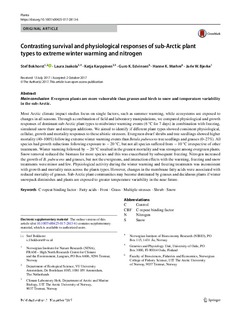| dc.contributor.author | Bokhorst, Stef | |
| dc.contributor.author | Jaakola, Laura | |
| dc.contributor.author | Karppinen, Katja | |
| dc.contributor.author | Edvinsen, Guro Kristine | |
| dc.contributor.author | Mæhre, Hanne Kirsti | |
| dc.contributor.author | Bjerke, Jarle W. | |
| dc.coverage.spatial | Sub-Arctic | nb_NO |
| dc.date.accessioned | 2017-11-24T08:57:23Z | |
| dc.date.available | 2017-11-24T08:57:23Z | |
| dc.date.created | 2017-11-21T13:05:27Z | |
| dc.date.issued | 2017 | |
| dc.identifier.citation | Planta. 2017, 1-14. | nb_NO |
| dc.identifier.issn | 0032-0935 | |
| dc.identifier.uri | http://hdl.handle.net/11250/2467944 | |
| dc.description.abstract | Main conclusion Evergreen plants are more vulnerable than grasses and birch to snow and temperature variability in the sub-Arctic. Most Arctic climate impact studies focus on single factors, such as summer warming, while ecosystems are exposed to changes in all seasons. Through a combination of field and laboratory manipulations, we compared physiological and growth responses of dominant sub-Arctic plant types to midwinter warming events (6 °C for 7 days) in combination with freezing, simulated snow thaw and nitrogen additions. We aimed to identify if different plant types showed consistent physiological, cellular, growth and mortality responses to these abiotic stressors. Evergreen dwarf shrubs and tree seedlings showed higher mortality (40–100%) following extreme winter warming events than Betula pubescens tree seedlings and grasses (0–27%). All species had growth reductions following exposure to − 20 °C, but not all species suffered from − 10 °C irrespective of other treatments. Winter warming followed by − 20 °C resulted in the greatest mortality and was strongest among evergreen plants. Snow removal reduced the biomass for most species and this was exacerbated by subsequent freezing. Nitrogen increased the growth of B. pubescens and grasses, but not the evergreens, and interaction effects with the warming, freezing and snow treatments were minor and few. Physiological activity during the winter warming and freezing treatments was inconsistent with growth and mortality rates across the plants types. However, changes in the membrane fatty acids were associated with reduced mortality of grasses. Sub-Arctic plant communities may become dominated by grasses and deciduous plants if winter snowpack diminishes and plants are exposed to greater temperature variability in the near future. C-repeat binding factor · Fatty acids · Frost · Grass · Multiple stresses · Shrub · Snow | nb_NO |
| dc.language.iso | eng | nb_NO |
| dc.subject | C-repeat binding factor | nb_NO |
| dc.subject | Fatty acids | nb_NO |
| dc.subject | Frost | nb_NO |
| dc.subject | Grass | nb_NO |
| dc.subject | Multiple stresses | nb_NO |
| dc.subject | Shrub | nb_NO |
| dc.subject | Snow | nb_NO |
| dc.title | Contrasting survival and physiological responses of sub-Arctic plant types to extreme winter warming and nitrogen | nb_NO |
| dc.type | Journal article | nb_NO |
| dc.type | Peer reviewed | nb_NO |
| dc.description.version | publishedVersion | nb_NO |
| dc.subject.nsi | VDP::Zoologiske og botaniske fag: 480 | nb_NO |
| dc.subject.nsi | VDP::Zoology and botany: 480 | nb_NO |
| dc.source.pagenumber | 1-14 | nb_NO |
| dc.source.journal | Planta | nb_NO |
| dc.identifier.doi | 10.1007/s00425-017-2813-6 | |
| dc.identifier.cristin | 1516650 | |
| dc.relation.project | Norges forskningsråd: 225006 | nb_NO |
| dc.relation.project | Andre: FRAM–High North Research Centre for Climate and the Environm | nb_NO |
| cristin.unitcode | 7511,4,0,0 | |
| cristin.unitname | Tromsø | |
| cristin.ispublished | true | |
| cristin.fulltext | original | |
| cristin.qualitycode | 2 | |
